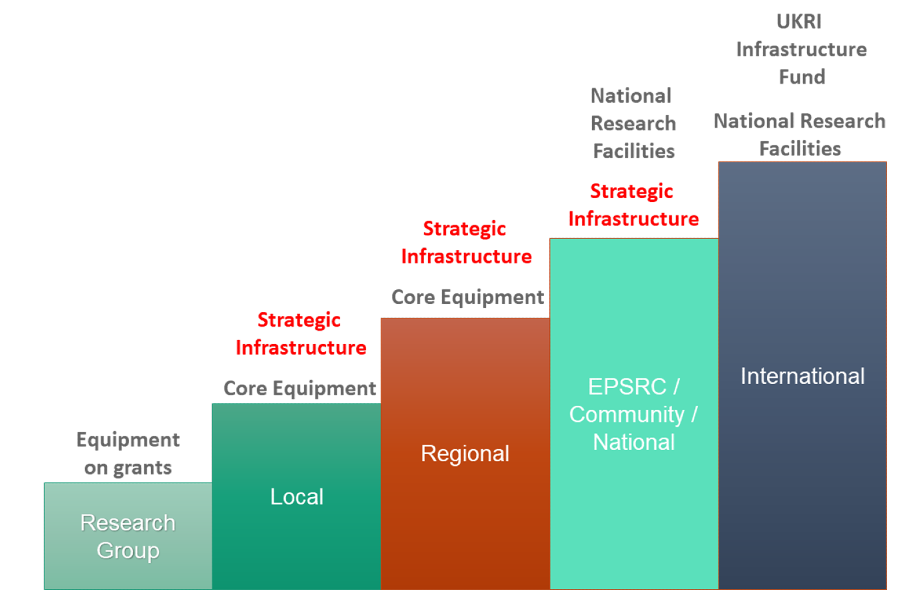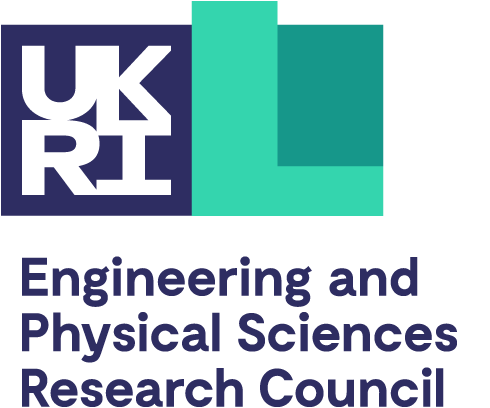Scope of scheme
Strategic infrastructure is intended to enhance UK scientific capability and support a portfolio of high quality, cutting edge research of high priority to EPSRC.
The request should fit with the host university strategy and enable research that predominantly falls within EPSRC’s remit.
Find out how strategic infrastructure fits into EPSRC’s approach to equipment funding.
Strategic infrastructure encompasses a wide range of equipment and resources. However, all requests should include the following details:
- justified cost
- appropriate use
- appropriate strategy
How to apply
You can apply to the outline stage of the EPSRC strategic infrastructure scheme using the UKRI Funding Service.
Find all the information on how to apply in the funding opportunity guidance for the current round:
The outline opportunity guidance includes:
- who can apply
- what we’re looking for
- how to apply
- how we will assess your application
- contact details
The full stage opportunity guidance can be seen from previous round: Strategic infrastructure for engineering and physical sciences: Oct 2023.
The information to provide in the request may vary in future rounds as the opportunity is taking a phased approach to onboard the new UKRI Funding Service.
The strategic staircase
 An appropriate strategic infrastructure case can be made in a number of ways at a number of different levels. It does not necessarily have to have national significance or be unique if the strategic argument in support of it will lead to world leading science being enabled.
An appropriate strategic infrastructure case can be made in a number of ways at a number of different levels. It does not necessarily have to have national significance or be unique if the strategic argument in support of it will lead to world leading science being enabled.
The strategic staircase is a way of linking:
- strategic importance
- the scale of the equipment use
- EPSRC’s equipment funding options
Strategic importance is about how the equipment enhances UK scientific capability and supports high quality research important to EPSRC.
There are different levels of strategic importance that all have a place in the EPSRC portfolio.
Strategic importance level one
Scale: research group
Funding option: equipment on grants funding
Strategic importance level two
Scale: local
Funding options:
- core equipment
- local strategic infrastructure
Strategic importance level three
Scale: regional
Funding options:
- core equipment
- regional strategic infrastructure
Strategic importance level four
Scale: EPSRC, community or national
Funding option: national strategic infrastructure
Strategic importance level five
Scale: international
Funding options:
- national research facilities
- UKRI infrastructure fund
Hypothetical examples of strategic equipment
Example 1
A state-of-the-art instrument which would be the first of its kind in the UK has been requested by a university. The unique capability would enable transformative research across several fields of research and a number of groups across the UK.
The host recognises that other institutions would want to access the novel equipment so 40% of instrument time would be open access with external steering committee members prioritising requests for access.
Example 2
A university requests a standard specification NMR instrument along with a high specification probe. The instrument will support a wide range of researchers across the university who all require access to the novel probe and will utilise the instrument fully.
The research enabled by the enhanced capability of the instrument aligns with the university’s strategic priorities and will allow it to boost its national (and potentially international) competitiveness in these areas.
The new instrument will also enhance capacity, allowing increased access for a cohort of researchers, accelerating their research. Any spare capacity will be advertised to external users across the region and to industry.
Example 3
A university requests a very high specification mass spectrometer that would be unique to the UK. The university specialises in mass spectrometry and therefore the instrument would support a large number of groups internally, with a large portfolio of existing research grants.
The instrument has the potential to transform the field of research or will allow the university to retain its world-leading edge in the area.
The university recognises that the unique instrument will be of interest to other institutions and therefore will reserve a percentage of time on the equipment for external users and have a proactive plan for attracting such users.
Example 4
A university has recently recruited a number of early career researchers (ECR) in areas of research that are a strategic strength for the institution. The university requested an item of equipment that would drive forward the ECRs’ research and careers enabling the academics to establish themselves as competitive researchers, as well as strengthening the position of the university in an important area.
University contributions
It is for the university to consider what an appropriate contribution towards the grant is. Contributions can come in many forms and include (but are not limited to):
- a direct contribution towards the infrastructure
- in-kind investigator time
- funding a research technical professional
- contributing refurbishment costs
The nature of the contribution should reflect the strategic importance of the infrastructure to the host organisation. Relevant factors may include:
- whether the equipment contributes a unique capability to the UK landscape
- it provides essential additional capacity for the UK
- the balance of usage at the departmental, regional or UK level
Useful resources
EPSRC held a webinar for potential applicants and research officers on 9 August 2023 for the strategic infrastructure outline opportunity. At the webinar, we provided information about the opportunity details and a chance to ask questions for the outline stage.
View the presentation given at the webinar (PDF, 1.22MB)
View the webinar questions and answers document (PDF, 135KB)
EPSRC held a second webinar for full proposal applicants and research officers on 22 November 2023. At the webinar, we provided information about the opportunity details and a chance to ask questions for the full proposal stage.
View the presentation given at the webinar (PDF, 2.22MB)
View the webinar questions and answers document (PDF, 128KB)
EPSRC held a webinar for potential applicants and research officers on 12 February 2024 for the strategic infrastructure outline opportunity. At the webinar, we provided information about the opportunity details and a chance to ask questions for the outline stage.
View the presentation given at the webinar (PDF, 1.27 MB)
View the webinar questions and answers document (PDF, 161 KB)
Contacts
If you have any questions about the strategic infrastructure process or if you are planning a resources to support existing research infrastructure proposal please use the following theme contacts.
Generic questions and submission of draft business cases
EPSRC equipment funding
Email: epsrcequipmentfunding@epsrc.ukri.org
Research infrastructure
Li Convey
Email: li.convey@epsrc.ukri.org
Stephen Gilligan
Email: stephen.gilligan@epsrc.ukri.org
Physical sciences
Audrey Nailor
Email: audrey.nailor@epsrc.ukri.org
Information and communication technologies (ICT)
Ben Scott
Email: ben.scott@epsrc.ukri.org
Engineering
Maria Calderon Munoz
Email: maria.calderonmunoz@epsrc.ukri.org
Healthcare technologies
John Baddeley
Email: john.baddeley@epsrc.ukri.org
Manufacturing and the circular economy
Tochukwu Ajare
Email: tochukwu.ajare@epsrc.ukri.org
Energy
James Tarver
Email: james.tarver@epsrc.ukri.org
Last updated: 7 March 2024


